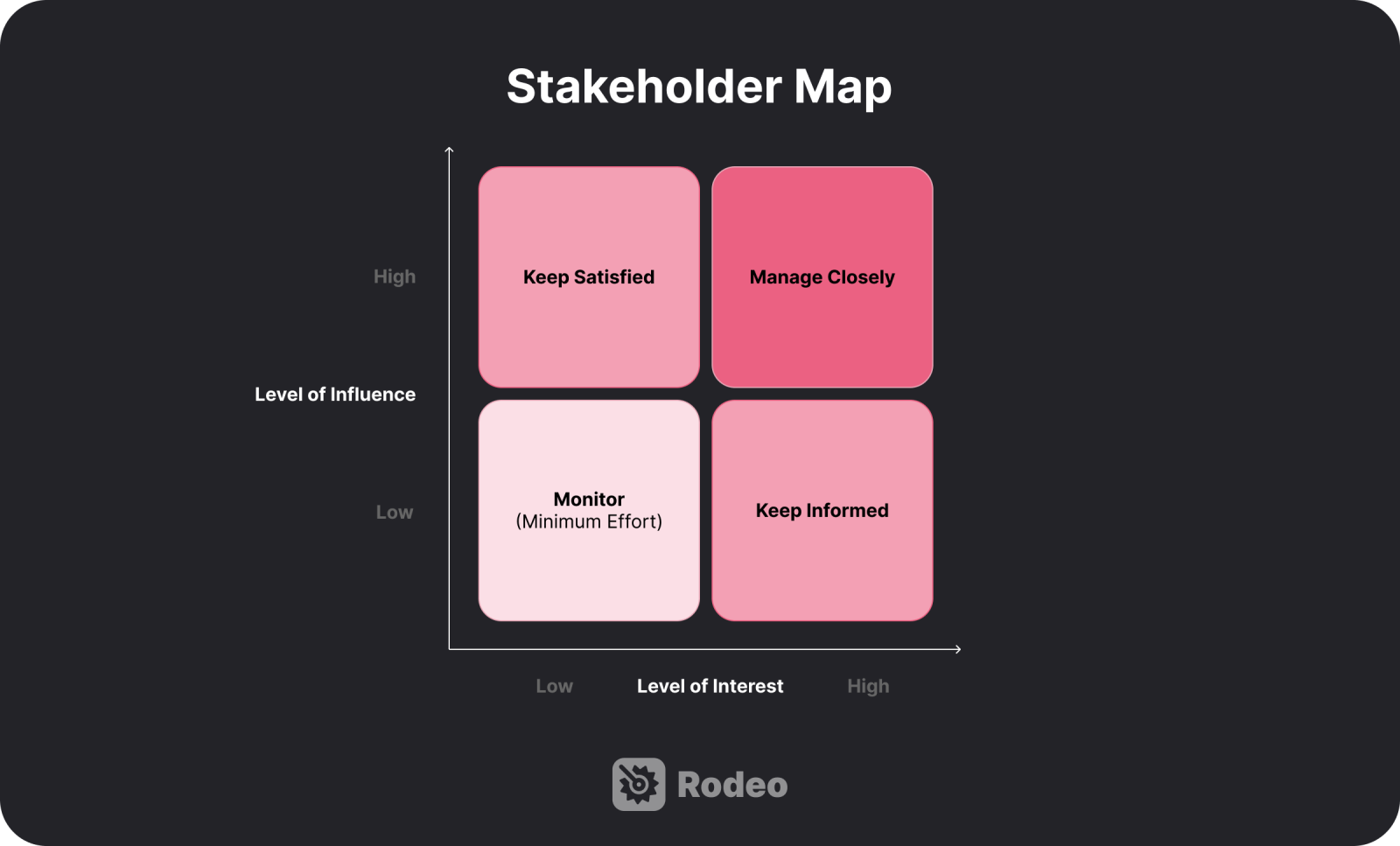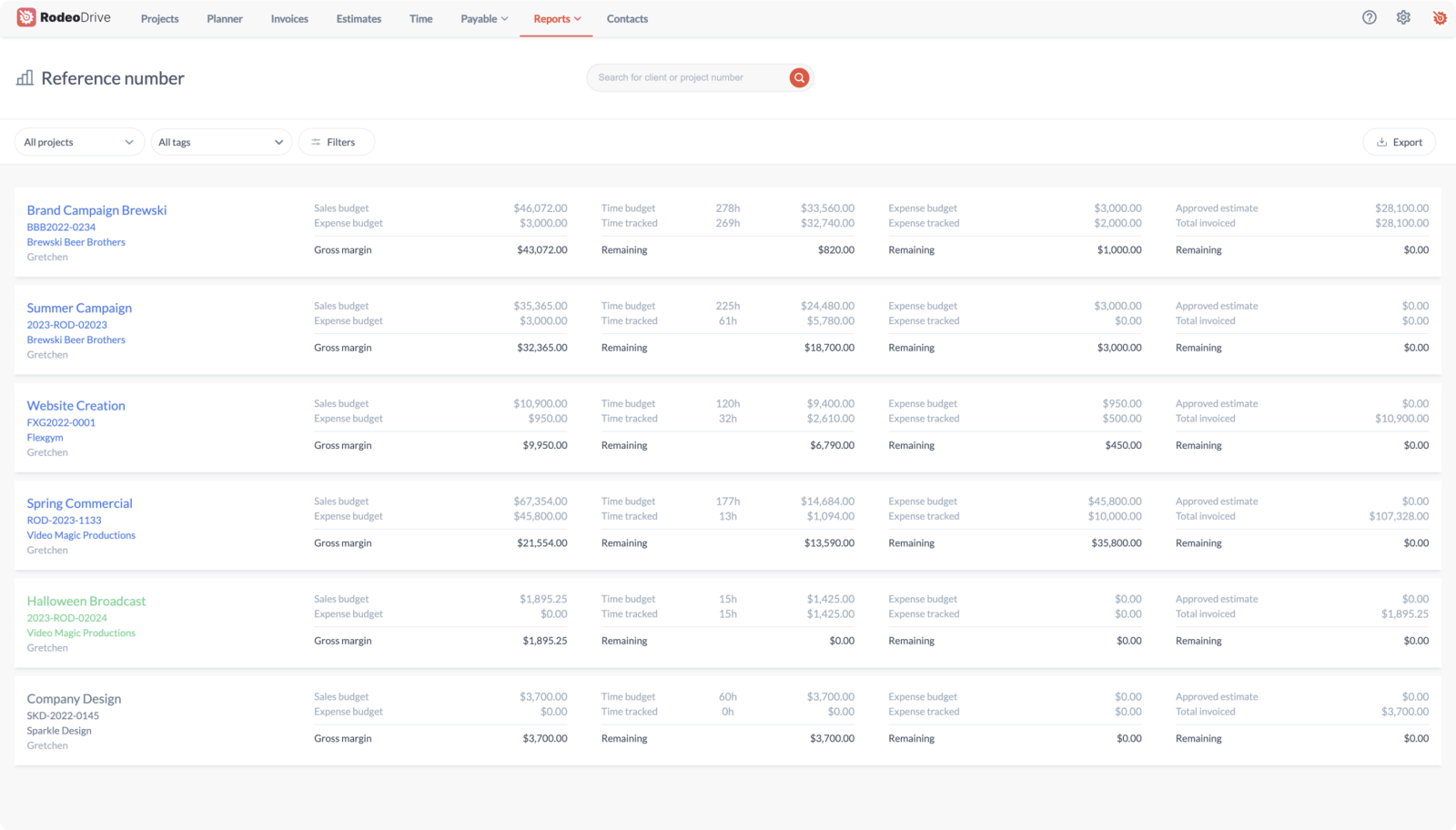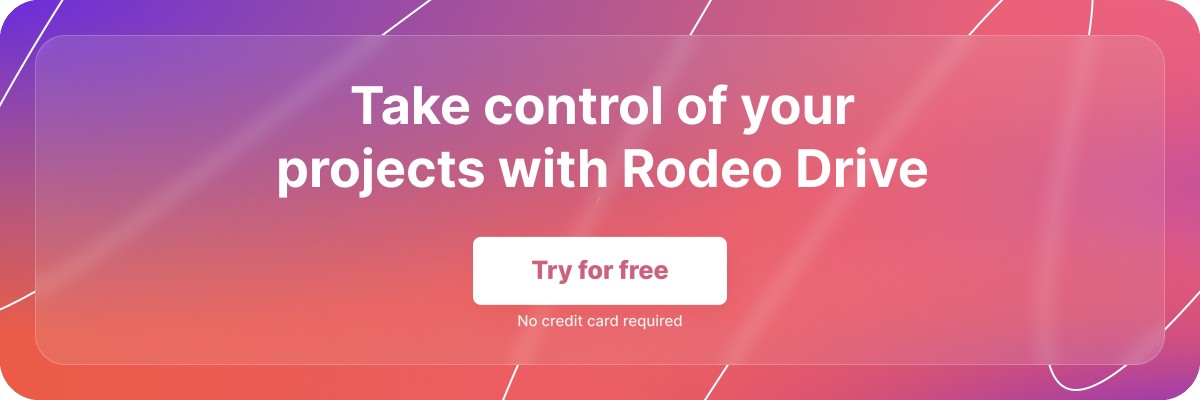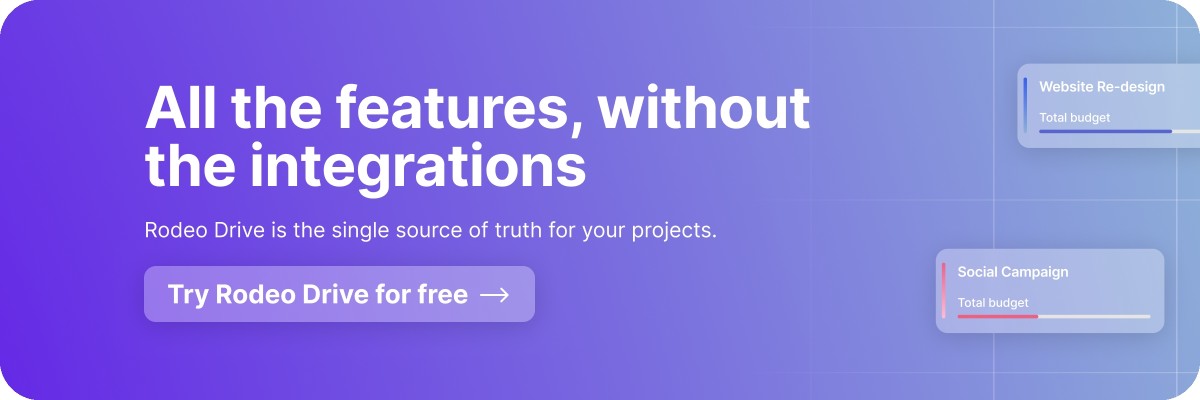Practicing Successful Stakeholder Management: A How-to Guide
If you’ve ever worked on a project where your client wasn’t happy with the project outcomes, then chances are, your stakeholder management practices were to blame.
Stakeholder management is a crucial part of project success that ensures the project team and other individuals impacted by the project are on the same page.
Below, you’ll find a complete overview of project stakeholders, why proper stakeholder management is important, plus 7 steps for an effective stakeholder management process.
What’s a project stakeholder?
A project stakeholder is any individual, group, or organization that has a vested interest in a project’s execution, or which are affected by its outcome. Stakeholders can include clients, team members, investors, end-users, or regulatory bodies.
In client-facing project work, your stakeholders are typically your client’s representatives or senior leaders within your organization who have a vested interest in making the project a success. Typically these stakeholders also have more control over the resources the project receives, which is why it’s so crucial to earn their buy-in.
Overall, stakeholder perspectives, expectations, and requirements are integral to the project's success, since stakeholders are often the ones setting requirements for the project objectives and outcomes.
Internal stakeholders
Internal stakeholders are individuals in the project team’s organization who either have an interest in the project’s success or direct involvement in the project’s execution.
Internal stakeholders might be managers or C-suite executives with enough experience to provide guidance or feedback to the project manager. Or, internal stakeholders may be people from other departments who are directly impacted by the project, such as someone from the finance or marketing teams.
Involving internal stakeholders in your project allows people with a deep understanding of your organization’s objectives and processes to share their perspectives and influence project decisions for better outcomes.
Related: Which Project Management Team Roles Are Key for Success?
External stakeholders
The main difference between internal and external stakeholders is their relationship to the organization executing the project.
External stakeholders are not involved in the internal structure of the organization managing the project but still have perspectives, needs, and expectations that are critical for the project to achieve its success criteria.
It’s crucial to include external stakeholders in your project, as oftentimes project outcomes need to be aligned with external requirements and regulations to be considered successful.
So, what’s stakeholder management?
Effective stakeholder management involves identifying, understanding, and engaging with stakeholders to ensure their needs are met and their concerns addressed throughout the project.
The goal of stakeholder management is to build positive relationships between stakeholders and the project team that help align everyone’s interests, ideally resulting in increased support for the project and minimized risks.
To accomplish this, stakeholder management might involve stakeholder mapping, communication planning, stakeholder engagement strategies, and regular monitoring to keep stakeholders satisfied and up to date on project progress.
It’s worth noting that stakeholder management isn’t a concept that’s limited to project management. Rather, managing stakeholder expectations is an important part of other fields too, such as business administration.

Benefits of stakeholder management
Stakeholder management might seem like just one more item on the project manager’s already long to-do list. However, there are several upsides to implementing a strong stakeholder management process that will benefit both your team and the stakeholders themselves.
Better communication
Good stakeholder management involves keeping stakeholders informed and involved throughout the project lifecycle. When there are clear channels for information exchange with stakeholders, the result is better communication.
Strong communication means fewer misunderstandings and miscommunications throughout the project lifecycle, resulting in increased trust and a stronger bond between stakeholders and team members.
Increased buy-in and support for the project
Stakeholder management helps to involve key stakeholders in the project decision-making process throughout the project’s entire lifecycle. This provides an avenue through which stakeholders can share their concerns and interests and have those directly addressed by the project manager.
Having this means of direct communication with stakeholders can be immensely beneficial in securing buy-in from these stakeholders to garner their support for the project. This engagement can lead to greater resource allocation, cooperation, and advocacy for the project.
All in all, when stakeholders feel more invested in a project’s outcomes, they’re more likely to contribute additional expertise, resources, and support to the project to ensure its success.
Reduced risks and increased alignment
Especially when your stakeholders include your client, you’ll want to make sure they’re aware of the project’s potential risks to guarantee that their expectations are realistic. This way, if a risk materializes and veers the project off course, your stakeholders won’t be blindsided.
Additionally, involving stakeholders in the risk management process helps build their confidence in the project's ability to address potential challenges, reducing the likelihood of conflicts, delays, or unexpected issues arising during project execution.
Also read: Keep Your Projects on Track With This Risk Register Template
How to practice successful stakeholder management in 7 steps
Stakeholder management is an ongoing process you’ll need to consider at every stage of your project. Failure to consider the needs and wishes of your stakeholders can leave them unhappy with your deliverables.
Investing time into engaging stakeholders throughout the entire project lifecycle will leave your project well-positioned for success. Here’s how you can approach stakeholder management in 7 easy steps.
1. Identify your key stakeholders
Before you get started creating any sort of stakeholder management plan, you need to identify the main stakeholders who have a key interest in your project or are impacted by its success. Don’t forget to consider both internal and external stakeholders during this step.
This step may function more as a brainstorming process, resulting in a rather long list of stakeholders. Don’t worry — we’ll sort this list in the next step of the stakeholder management process.
2. Prioritize stakeholders by interest, influence, and impact
Now that we have a long list of stakeholders, it’s time to determine which ones are most critical to project success — in other words — which ones require the highest level of engagement.
A good way to do this is by examining the interest, influence, and impact of each stakeholder to determine where they fit within your project. Creating a stakeholder map is the best way to categorize this information visually.
Sometimes referred to as a stakeholder matrix or a power-interest grid, your stakeholder map showcases the stakeholder’s level of influence on the Y-axis, representing their ability to impact the project. The X-axis, on the other hand, measures the stakeholder’s level of interest, which corresponds to the degree to which stakeholders are impacted by the project’s outcomes.

Each stakeholder should be plotted on your stakeholder map for a clear understanding of their relationship to the project. This then dictates the frequency of communication needed with each stakeholder, as well as what information they should receive.
In general, stakeholders with a high level of interest and influence are considered key stakeholders who should be closely managed. Conversely, a low-influence, high-interest stakeholder might be the end-user of a product or service who may be updated on your team’s progress, although infrequently.
3. Understand stakeholder needs and expectations
Now that you have a more complete understanding of who your key stakeholders are, it’s time to better understand their needs, expectations, and motives. After all, it will be difficult to deliver project outcomes everyone will be happy with if you don’t know what they want out of the project.
Creating a stakeholder profile for each main stakeholder can be time-consuming but well worth it for projects where stakeholder buy-in and support are top priorities. In each profile, you’d want to pinpoint how this project aligns with their individual priorities. This provides a clear picture of how each stakeholder views the project.
There are multiple different approaches you can take to understand stakeholder needs and motivations. Interviews are a great method that allows for a deeper understanding of each stakeholder’s perspective. Or, if you’re working on a tight deadline or with dozens of stakeholders, surveys or focus groups are a great way to gather information efficiently.
Regardless of how you go about it, gathering information on stakeholder perspectives is a necessary part of conducting a stakeholder analysis that will result in an engagement plan that appropriately meets everyone’s needs.

4. Devise a plan for stakeholder engagement
Now that the information-gathering process is complete, it’s time to turn the insights you’ve captured into a plan of action.
Your stakeholder management plan should include all of the information you’ve gathered until this point, including your list of key figures. As for how you plan to engage stakeholders, you’ll want to answer the following questions and record your answers within the plan:
- How often will you communicate updates to key stakeholders? What about your less prominent stakeholders?
- What types of risks should you consult with your stakeholders on?
- Are there any tasks outlined in the project plan that require stakeholders to make decisions?
- How will your team approach conflict resolution with stakeholders?
- What types of reports can stakeholders expect from your team, and with what frequency?
In other words, think of your stakeholder management plan as documentation that records how you plan to work with them throughout the project to leave them satisfied with your team’s work.
5. Establish clear lines of communication
Good communication is at the heart of effective stakeholder management. This is why many project managers create a project communication plan so everyone is on the same page regarding how often communication will occur and through which channels.
The same applies to your stakeholder communication as well. It’s important that you understand how key stakeholders prefer to communicate with your team. That way, you can easily consult them when roadblocks arise.

6. Regularly check in with stakeholders
Although stakeholder management can be rather time-intensive at the beginning of your project, it’s important to keep it up throughout your project lifecycle.
Regularly touching base with your stakeholders can establish a relationship built on trust and transparency and reduce the likelihood of misunderstandings or conflicts. This way, stakeholders can raise their concerns with your team directly and give you the opportunity to address those concerns.
7. Opt for the right project management software tool
Stakeholder management is a lot to handle, but a project management tool can significantly reduce the burden that falls on the project manager’s plate.
For starters, a project management tool centralizes all of your project information, which ensures your documentation is properly organized when you need to retrieve it to answer stakeholder questions.
In general though, a project management tool dramatically increases your likelihood of project success. This is because most tools offer advanced project progress reporting and tracking capabilities, which help you identify and mitigate risks for the project before they completely derail it.
Related: 15 Client Management Tools for Project Management
Keep stakeholders up to date with the help of Rodeo Drive
If you’re looking for a project management tool to help with your stakeholder management processes, you’re in the right place. Rodeo Drive is a tool built to see your projects through at every stage of their lifecycle, from planning to execution.
The platform does this with the help of its various features, which include budgeting, time tracking, activity planning, invoicing, and reporting, to name a few.
Here’s a closer look at some of the features that will be helpful for a team looking to improve its relationship with stakeholders:
Free guest users to keep stakeholders up to date
Users on Rodeo Drive’s Achiever plan can add guest users to their projects in the platform at no additional cost, meaning you can give your stakeholders access to your project progress directly.
From a stakeholder management perspective, this helps reduce the amount of back and forth that occurs between you and your stakeholders. For example, using guest access they can check what your team is working on without having to ask.
Reports that provide a real-time overview of project progress
Rodeo Drive connects all aspects of your project, from budgeting to time tracking. This allows for complete visibility into your project progress using the platform’s reporting feature.
Rodeo Drive offers three different reports — Time, Productivity, and Projects, the latter of which provides a complete overview of your project’s financial performance, including profit margins, expenses incurred, and amounts invoiced.

Rodeo Drive’s Projects report provides an overview of each project’s financial health
All of Rodeo Drive’s reports can be filtered by team member, project, or date range for additional clarity. This is especially helpful when fielding stakeholder questions on your team’s progress.
Need to create your own custom reports? All of your team’s data from Rodeo Drive can be exported as an Excel or CSV file and for your own use.
The best part — signing up for Rodeo Drive is completely free. Come try it out for yourself, or schedule a demo.








